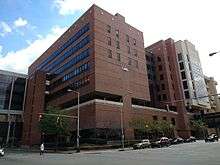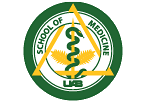University of Alabama School of Medicine
The University of Alabama at Birmingham (UAB) School of Medicine (also known as University of Alabama School of Medicine) is a public medical school located in Birmingham, Alabama, United States with branch campuses in Huntsville, Montgomery, and at the University of Alabama College of Community Health Sciences in Tuscaloosa. Residency programs are also located in Selma, Huntsville and Montgomery.
 | |
Former names | Medical College of Alabama |
|---|---|
| Type | Public |
| Established | 1859[1] |
| Dean | Selwyn Vickers, M.D. |
| Location | , , 33.500000°N 86.807500°W |
| Website | https://www.uab.edu/medicine/home/ |
 | |
History
Founding and growth
The School of Medicine at UAB can trace its roots to the 1859 founding of the Medical College of Alabama in Mobile, Alabama. In the early 1900s, due to the work of Abraham Flexner, the medical school became more closely affiliated with the University of Alabama. The move of the college from Mobile to Tuscaloosa took effect in 1920.[1]
In 1936, the University of Alabama Extension Center was opened in Birmingham.[2] In 1943, Governor Chauncey Sparks created the four-year Medical College of Alabama with the passage of the Jones Bill (Alabama Act 89). In 1944, Roy R. Kracke was named dean of the Medical College of Alabama and began assembling teaching staff.{Robert R. Kracke and William G. Kracke, The University of Alabama Medical Center: the Past, the Present, the Future,” Alabama Lawyer 28(1967):78-88}
In 1945, the Medical College of Alabama was moved from Tuscaloosa to Birmingham and the university's medical center was founded.[1] In November 1966, the Extension Center and the Medical Center were merged to form the "University of Alabama in Birmingham," an organizational component of The University of Alabama. In 1969, UAB became an independent institution, one of three autonomous universities within the newly created University of Alabama System. The university's name was changed in 1984 from the "University of Alabama in Birmingham" to the "University of Alabama at Birmingham."
As of 2019, the School of Medicine has 805 students, 990 residents and 1,483 faculty in 27 academic departments.[3] The UAB School of Medicine is home of The Kirklin Clinic, a multi-disciplinary medical home; University Hospital, one of the largest academic hospitals in the country; and faculty serve the new Children's of Alabama hospital.[4]
Regional and national emergence
Tinsley R. Harrison M.D. became dean of the new medical school and chairman of the Department of Medicine in 1950. Dr. Harrison began a program of recruitment aimed at making the school a major research and health care center.
In 1966, John W. Kirklin, M.D., joined UAB as chairman of the Department of Surgery and Surgeon-In-Chief for University Hospital from Mayo Clinic. He was most noted for revolutionizing cardiovascular surgery through his development and refinement of the heart-lung machine.[5]
Leadership

On August 15, 2013, UAB announced Selwyn Vickers, M.D., would be the next senior vice president for Medicine and dean of the School of Medicine effective October 15, 2013. Vickers spent his formative years as a young faculty member at UAB, beginning in 1994, and he directed the section of gastrointestinal surgery from 2000 to 2006. He was previously the Jay Phillips Professor and Chair of the Department of Surgery at the University of Minnesota Medical School.[6]
Anupam Agarwal, M.D., served as interim dean of the School of Medicine for eight months from February to October 2013 after Ray Watts, M.D., former dean of the School of Medicine, was named the seventh president of UAB in January 2013. Agarwal returned to his position as director of the Division of Nephrology and vice chair for research in the Department of Medicine on October 15, 2013.
Campuses
The main campus of the School of Medicine at UAB is located in Birmingham, not to be confused with the original University of Alabama campus located in Tuscaloosa, AL. All students complete their first two years at the main campus in Birmingham. The remaining two years can be completed in Birmingham or at one of three branch campuses in Tuscaloosa, Montgomery or Huntsville.[7]
Tuscaloosa
In 1974 the University of Alabama created the College of Community Health Sciences. This is a college organized under the University of Alabama, and in conjunction with the University of Alabama School of Medicine provides medical education for the 3rd and 4th years of students who choose to study in Tuscaloosa.
Huntsville
The School of Medicine maintains a branch campus in Huntsville affiliated with Huntsville Hospital. The Huntsville campus was originally a part of the University of Alabama in Huntsville; however, in 1974 UAB assumed control over the Huntsville program.
Montgomery
UAB's Montgomery campus is a collaborative effort among UAB, Baptist Health and the city of Montgomery. Beginning in May 2014, 10 third-year medical students began taking classes in Montgomery.
Admissions
For the class entering in 2013, the average MCAT score was 30.0 and the median undergraduate GPA was a 3.72. Of this same year 2,866 applied, 373 were interviewed, 267 were accepted, and 185 matriculated.
Distinctions
- In 1960, Dr. Basil Hirschowitz was the first to explore the stomach with his new invention, the fiber-optic endoscope, which is now in the Smithsonian Institution.
- UAB heart surgeon, the late John W. Kirklin, developed a computerized intensive care unit that became a model for modern ICUs around the world. They help improve care and reduce complications. Kirklin initially gained fame by improving the safety and usefulness of the heart-lung bypass pump.
- The Diabetes Research and Education Hospital was dedicated in March 1973, as the first public, university-affiliated diabetes hospital in the nation.
- In 1977, Dr. Richard Whitley administered systemic antiviral for the treatment of the deadly HSV (herpes simplex virus) encephalitis, leading to the world's first effective treatment for a viral disease.
- The first use in the United States of color doppler echocardiography for visualizing internal cardiac structures was introduced by Dr. Navin C. Nanda and occurred at UAB Hospital in 1984.
- In 1986, Dr. Thomas N. James, then chairman of UAB's Department of Medicine, presided over the tenth World Congress of Cardiology held in Washington, D.C.
- World's first genetically engineered mouse-human monoclonal antibody was used at University Hospital in the treatment of cancer in 1987.
- Dr. John Richard Montgomery, known for co-implementing the environmental bubble used to protect David Vetter, has served as the chief of pediatric programs at the Huntsville campus.
- The first simultaneous heart-kidney transplant in the Southeast was performed at UAB by doctors David C. McGiffin and David Laskow in 1995.
- The journal Science named three UAB faculty, doctors Michael Saag, George Shaw, and Beatrice Hahn, among the top 10 AIDS researchers in the country, and highlighted the AIDS research program at UAB in 1996.
- The AIDS Vaccine Evaluation Unit (AVEU) became the first evaluation unit to enter a Phase III trial of an AIDS vaccine in 1999.
- UAB's Kidney Transplantation Program is the world's leading transplant program, with more than 5,000 transplants being performed since 1968. In each of the last seven years, more kidney transplants have been performed at UAB than at any other institution in the world. UAB is also a national leader in other organ transplants.
- The UAB AIDS Center was the first to perform clinical trials of the protease inhibitor Indinavir (Crixivan), one of the first protease inhibitors used in the [triple-drug cocktail] to fight HIV.
- UAB researchers were the first to discover the protein that led to the development of the now well-known drug Viagra, causing what some have called the second sexual revolution.[8][9]
- UAB hosts one of only 45 Medical Scientist Training Programs in the country. A highly selective program funded by grants from the National Institutes of Health, the UAB MSTP offers students the ability to earn both an M.D. and a Ph.D during a 6- to 8-year time period. During this time, all tuition is waived and a stipend of $25,000 per year is awarded. Generally, 6 to 10 students per year are admitted to the program.
Rankings
- In the 2018 edition of U.S. News & World Report, the University of Alabama at Birmingham (UAB) School of Medicine was ranked No. 21 nationally in research.[10]
- Within the School of Medicine, six departments ranked in the top 10 for NIH funding in their fields, led by the Department of Dermatology, which held the top spot as the most funded dermatology department in the nation.
The Department of Ophthalmology and Visual Sciences ranked fifth, the Department of Biomedical Engineering ranked fifth, and the Department of Obstetrics and Gynecology came in at ninth in the nation, as did the Department of Cell, Integrative and Developmental Biology. The Department of Anesthesiology was 10th on the NIH funding list.
Notable faculty and alumni
- Dr. Tinsley R. Harrison, who served as dean of the Medical School and chair of the Department of Medicine, was the editor of the first five editions of Harrison's Principles of Internal Medicine.
- Regina Benjamin, former Surgeon General, attained her medical degree from the University of Alabama School of Medicine.
- Jeanne Marrazzo, director of the University of Alabama School of Medicine Division of Infectious Diseases
References
- "The University of Alabama at Birmingham (UAB)". www.uab.edu. Retrieved 2019-03-10.
- "UAB - Libraries - UAB History". library.uab.edu. Retrieved 2019-03-10.
- Gorelick, Kerry. "UAB - School of Medicine - Facts & Figures". www.uab.edu. Retrieved 2019-03-10.
- Gorelick, Kerry. "UAB - School of Medicine - About".
- "Archived copy". Archived from the original on 2006-09-18. Retrieved 2006-07-01.CS1 maint: archived copy as title (link)
- Colmenares, Clinton. "UAB - School of Medicine - News - Selwyn Vickers, M.D., chosen to lead UAB School of Medicine".
- "UAB - School of Medicine - Campuses".
- "Archived copy". Archived from the original on 2006-07-02. Retrieved 2006-07-01.CS1 maint: archived copy as title (link)
- Ennis, Lisa. "UAB - Lister Hill Library - LHL Historical Collections".
- "NIH funding to UAB nears $300 million". UAB News. Retrieved 2020-01-26.